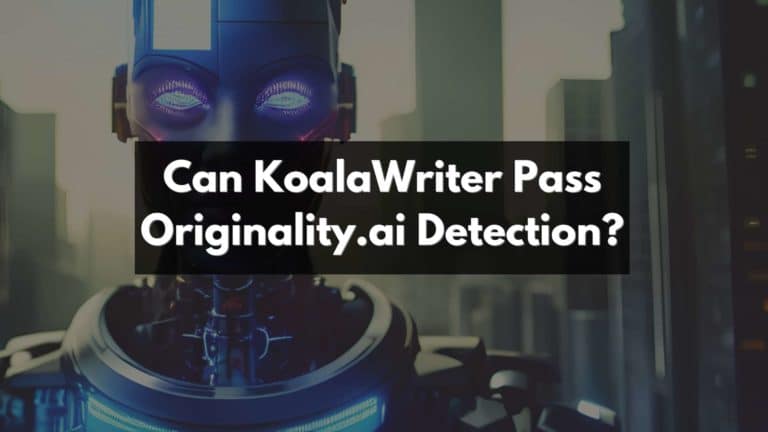Can ParagraphAI Pass Originality.ai Detection?
Frustrated with AI-written content being detected? It’s a challenge I know well. Having studied the accuracy and limitations of various AI detection tools, including Originality.AI’s 94% efficiency in detecting certain AI models, I’ve discovered there’s more to this than meets the eye.
This blog reveals key insights into whether ParagraphAI can evade Originality.ai detection, exploring possible loopholes and ethical considerations along the way. Ready for answers? Let’s dive in!
Key Takeaways
- AI-detection tools are designed to analyze and identify AI-generated content, but they may struggle with rapidly evolving large-language models like ParagraphAI.
- Strategies such as humanizing content, revising text, and avoiding clichés can help an AI writer create undetectable content.
- Using undetectable AI-generated content raises ethical concerns regarding academic integrity and plagiarism. Clear guidelines for detecting AI-written text are crucial in maintaining credibility and upholding standards of integrity.
Understanding AI-Detection Tools
AI-detection tools are software programs designed to analyze and identify AI-generated content, helping to detect plagiarism and ensure originality.
What are AI-detection tools?
AI-detection tools are advanced software programs that discern between content created by humans and those generated by artificial intelligence. These tools leverage complex algorithms to analyze text patterns, frequencies, inconsistencies, or anomalies typically seen in AI-generated content.
They work on the basis of predictive analytics, drawing conclusions from large language models. Technologies like Originality.ai have an accuracy rate as high as 94% when identifying works created by sophisticated AI models such as GPT-3 and ChatGPT.
However, despite their effectiveness, they may still struggle with rapidly evolving large-language models or particularly well-disguised AI content. The exact degree of efficiency can vary depending on the tool used for detection and the model used to create the piece.
How do they work?
AI-detection tools, such as Originality.ai, work by using sophisticated algorithms and natural language processing models to analyze text for similarities with existing content. These tools compare the submitted text with a vast database of sources, including books, articles, and websites, to determine its originality.
The AI detection process involves examining patterns in sentence structure, word choice, and overall composition. However, it’s important to note that AI detection systems are not foolproof and can have limitations in accurately identifying AI-generated content.
As large-language models like GPT-3 continue to advance, it becomes increasingly challenging for these tools to differentiate between human-written and AI-generated text.
Can ParagraphAI Pass Originality. ai Detection?
I will analyze the effectiveness of AI-detection on content generated by ParagraphAI and explore potential loopholes or strategies to bypass detection.
Analyzing the effectiveness of AI-detection on ParagraphAI-generated content
I analyzed the effectiveness of AI-detection on content generated by ParagraphAI, a popular AI writing tool. The study revealed that most AI detection systems struggle to identify text produced by this advanced language model accurately.
Websites claiming to catch AI-written text often fail in their attempts, indicating the limitations of current AI content detection tools. While some tools like Originality.ai boast high accuracy rates, there is still room for improvement as large-language models continue to evolve.
Therefore, finding an AI content writer who can pass these detectors remains a challenge.
Potential loopholes or strategies to bypass detection
I have researched potential loopholes and strategies to bypass AI content detection. Here are some techniques that may help an AI content writer create undetectable content:
- Humanizing Content: By adding personal anecdotes, emotions, or subjective language, an AI-generated text can appear more human-like and deceive AI detectors.
- Content Revision: Modifying the grammar, sentence structure, and vocabulary of the generated text can make it less recognizable by AI systems.
- Text Rewriting: Paraphrasing or rewording sections of the text can help evade detection by making it appear less similar to existing content in database records.
- Avoiding Clichés and Common Phrases: Using unique expressions, idioms, or uncommon phrases can make the AI-generated text stand out and avoid detection based on typical language patterns.
- Utilizing Tools for Text Revision: There are various online tools available that can help revise generated content to make it more natural and less detectable by AI algorithms.
- Experimenting with Different Models: Trying out different AI models and platforms may yield varying results in terms of detection accuracy, so writers can explore options beyond well-known models like GPT-3 or ChatGPT.
Ethical Considerations and Consequences
Using AI-generated content without detection raises significant ethical concerns and can have serious consequences, particularly in relation to academic integrity and plagiarism. The implications of bypassing originality detectors can undermine the credibility of educational institutions and devalue the hard work and effort put into creating original content.
It is crucial to consider these ethical considerations when utilizing AI-generated text and to prioritize maintaining the highest standards of integrity in all forms of communication.
Implications of using AI-generated content without detection
Using AI-generated content without detection can have significant implications. Firstly, it raises ethical concerns regarding academic integrity and plagiarism. If AI-written content goes undetected, individuals may pass off this content as their own original work, leading to dishonesty and unfair advantages in academic or professional settings.
Furthermore, relying on undetectable AI-generated content undermines the value of human creativity and expertise. It diminishes the need for genuine human authors when automated systems can produce seemingly authentic content.
This could have far-reaching consequences for the publishing industry and journalistic integrity.
Moreover, failing to detect AI-generated content also means that inaccurate or biased information may go unchecked. As AI continues to evolve and improve its ability to mimic human writing styles, it becomes increasingly challenging to distinguish between genuine human-authored texts and those generated by machines.
Academic integrity and plagiarism concerns
Maintaining academic integrity and addressing plagiarism concerns are crucial when it comes to AI-generated content. With the rise of AI writing tools, there is a growing need to ensure that the content produced is original and properly attributed.
Plagiarism not only undermines the credibility of writers but also devalues the hard work put in by others. It is essential for both writers and users of AI-generated content to be aware of these concerns and take necessary measures to uphold academic integrity in their work.
Conclusion
In conclusion, while AI detection tools like Originality.ai have made significant advancements in identifying AI-generated content, there are still loopholes and strategies that can be utilized to bypass detection.
The effectiveness of these tools may vary depending on the specific AI system being used. It is crucial for users to consider ethical implications and consequences associated with using undetectable AI content, as it raises concerns about academic integrity and plagiarism.
Further research and development are needed to improve the accuracy of AI detection systems in order to maintain content originality and uphold standards of integrity.
FAQs
1. Can ParagraphAI pass Originality.ai detection?
ParagraphAI is designed to aid in generating unique and original content, but it does not guarantee that the generated text will pass detection by Originality.ai or any other plagiarism detection tool. It is always advisable to review and check the output of AI-generated content for originality before submitting it.
2. How effective is Originality.ai in detecting plagiarism?
Originality.ai utilizes advanced algorithms and techniques to detect potential instances of plagiarism by comparing submitted texts against a vast database of sources. While it can be an effective tool, no plagiarism detection software is perfect and there is always a possibility of false positives or missed instances. It’s important to use such tools as one part of a comprehensive approach to ensure academic integrity.
3. Are there any limitations to using Originality.ai?
While Originality.ai can be valuable in identifying potential cases of plagiarism, it may have certain limitations. It primarily focuses on similarities between texts rather than assessing the intent or understanding behind them. Additionally, if certain sources are not within its database or if content has been paraphrased adequately, it might not detect instances of plagiarism.
4. What actions should I take if my text doesn’t pass Originality.ai detection?
If your text doesn’t pass through Originality.ai’s detection system, you should carefully review the flagged areas and compare them with your referenced sources or citations. Make necessary revisions by properly paraphrasing or citing the original source to avoid unintentional plagiarism. Seeking guidance from your teacher, professor, or utilizing additional proofreading tools can also help ensure your work meets the required standards for originality.







